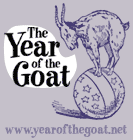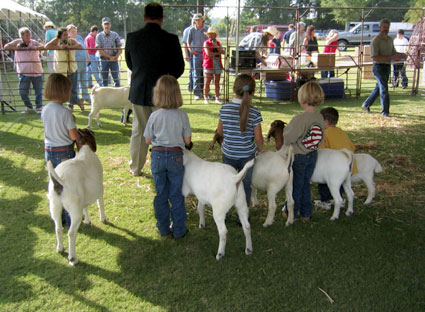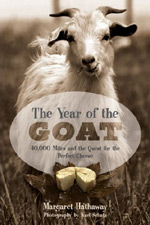If there is anything more adorable than small animals and children in costumes, it is a group of small animals being arranged by small, serious children in Wranglers, hand-tooled leather belts and 4-H t-shirts. The looks of intense concentration on their faces as they tried to remember everything and keep their unruly goats under control were so sweet and earnest that they were nearly heartbreaking. The judge seemed to think this as well, and before announcing his placements he said that of all the categories he judged, this was one of the most difficult.
Having never seen a goat show before, it was fascinating for us to watch Anton Ward evaluate the animals and their handlers. He is South African, and judges goats in the South African style, which means that in categories other than showmanship he allows the animals to run freely around the pen, letting them "show themselves" (or, as Karl put it, "they turn them loose and poke them with sticks"). Before the actual goat showing, however, there was adult showmanship, for which Judge Ward asked the help of the 4-H winners. Inviting the children into the ring, Judge Ward explained what qualities he looked for in each handler, and then had the children consider each entry. It was a great way to teach showmanship and, as the commentator kept saying, "the opportunity of a lifetime."
By this point in the day, the contestants in the goat barbecue cookoff had been at it for several hours. We took a break from the judging to have a look at the barbecue teams. Each crew had a grill set up on a platform, with a tent and tables spread out in front. The grills looked like giant steel drums that had been turned on their sides and hinged to open, with a door in the back into which hot coals were periodically shoveled. We had stopped in front of one, the Tennessee Trash Cookers, to look at their vast collection of trophies from years past, many of them topped with golden goats, when the clouds that had become increasingly threatening opened into torrential rains.
John Abel, one of the founding Trash Cookers, invited us to take refuge in his tent, and while we waited for the weather to clear, he explained a little about goat meat preparation (most important: clear the skin of all hair!), and regaled us with stories of previous Goat Days. John, his wife, and another couple had been competing in the festival's cookoff for years, and had won in various categories and under various, often soggy, conditions. As he passed through the rain between the tent and the barbecue, John said that this was nothing compared to a few years ago, when they'd been nearly a foot deep in water. Apparently, it always rains on Goat Days.
We sloshed our way from the barbecue back to the Boer judging, where the pen was full of water and recalcitrant goats. Goats hate to be wet, and though Judge Ward was splashing through the ankle-deep muck and hay to observe them, the goats were mostly trying to find dry ground at the edges of the pen. A few minutes after we arrived, volunteers began moving the pen to an area that was higher and a little sloped, about twenty yards away.
The pen was reassembled and the judging had been underway for about fifteen minutes when there was a loud boom, which set off dozens of goats and car alarms. Karl and I, less than a month out of New York City, jumped, but no one else seemed to be nervous. A few minutes later, there was another boom and we turned toward the source in time to see a huge anvil flying through the air like something from Wile E. Coyote and Roadrunner. It was noon. It was the National Championship Anvil Shoot. It was one hundred pounds of pointy metal shooting from a cannon into the sky.
The anvils kept flying, and soon, as the afternoon's events picked up, we were shuttling back and forth across the fairgrounds, from the children's milking contest to the largest goat judging, back to the adult's milking contest (which we only caught a few minutes of), and finally to the barbecue pit.
At three o'clock, courtesy of the Tennessee Trash Cookers, who sadly didn't win the cookoff this year, we had our first taste of goat. We had been a little anxious about trying it--what if we didn't like it?--but it was tasty, especially slathered in their secret sauce. The meat was brown and a little fibrous, crispy on the sauce end and moist in the center. It had the consistency of pulled pork, with a little hint of goatiness to its flavor. I'll confess it was pretty strange to be eating an animal that we had been petting all day, that we'd seen dressed up in costumes and that the whole festival was celebrating. But we had little time for philosophical musings, since the goat chariot races were being announced and John Abel was shooing us over to the course, an elliptical track marked with bales of hay.
During the race, each goat pulls a chariot in which the driver kneels while holding the reins. (Chariot blueprints and the official dimensions of the race track can be found on the Goat Days web site.) The goat races were serious business, and brought competitors from farther away than we'd imagined. A man named Jose was rumored to be the favorite, having won the last few years with goats he brought up from Texas.
The purse was a thousand dollars to the winner, and several hundred to second and third places, but the racing, because of the goats themselves, was unpredictable. Some goats who are fast and focused in practice get distracted during the race, or simply stop half way. Others begin munching the hay that marks the course. One kept rearing and nearly overturning its chariot. Two became tangled in each other's horns. The races were mayhem and the results were surprising. Neither of Jose's goats even got off the line. In the final race, one of the goats sped three quarters of the course and then just stopped. Touching the goats with anything but the reins is illegal, so the driver simply shouted encouragement and curses, and kept slapping the reins as the other goats caught up and passed.
The ultimate winner this year was Kenneth Thompson, of Sommerville, Tenn., driving a goat named Power Stroke. With this win, Kenneth, a four time champion in the 1990s, broke out of a four year slump. He'd only been training with Power Stroke for nine days, he said, and he claimed they'd barely practiced, but somehow the team emerged victorious.
Our team was again exhausted by seven. We'd been on our feet since the early morning pill flip, and by sunset, after some more goat barbecue and inadvertent participation in a Boy Scout flag retirement ceremony, we were ready to call it a day.
On the way back to our tent, we found that another couple had set up camp not far from ours. They were sitting outside as we walked by, and tethered to their van was a little goat who began, as we came nearer, to retreat shyly between the wheels. They hadn't meant to buy a goat, the woman said, but everything had fallen into place and now they were just trying to think of a good name. Zipped into our tent, we fell to sleep a little bit envious, dreaming of goats and wishing we had a kid of our own.


